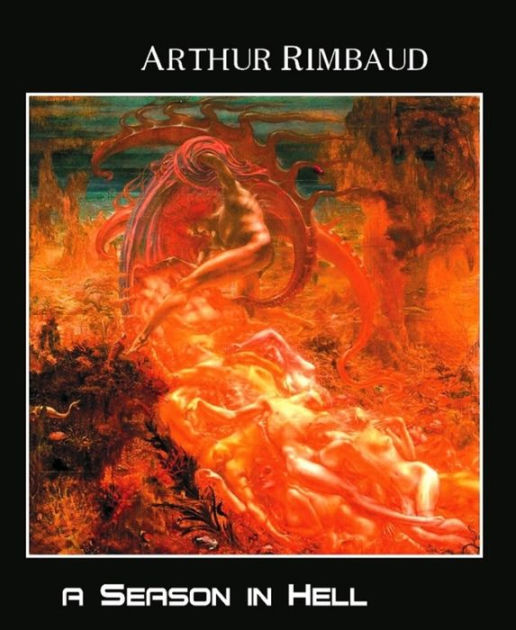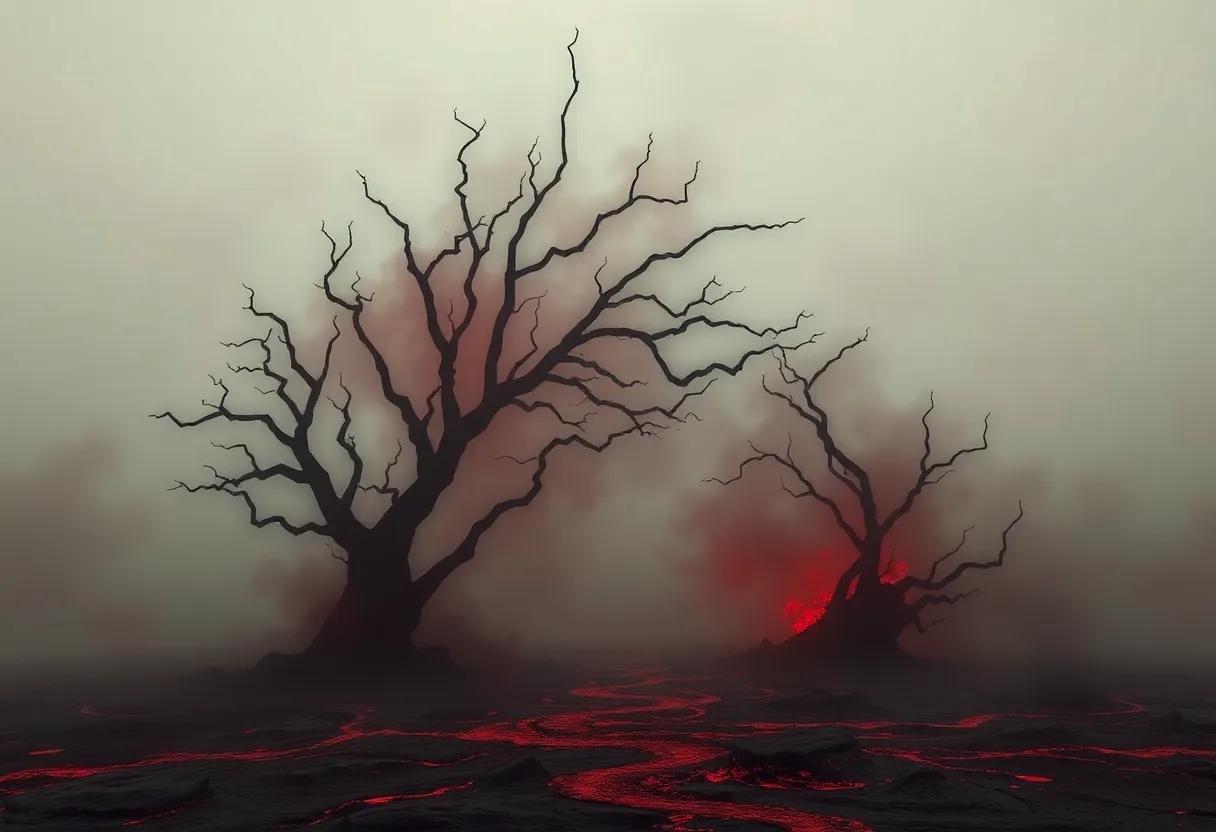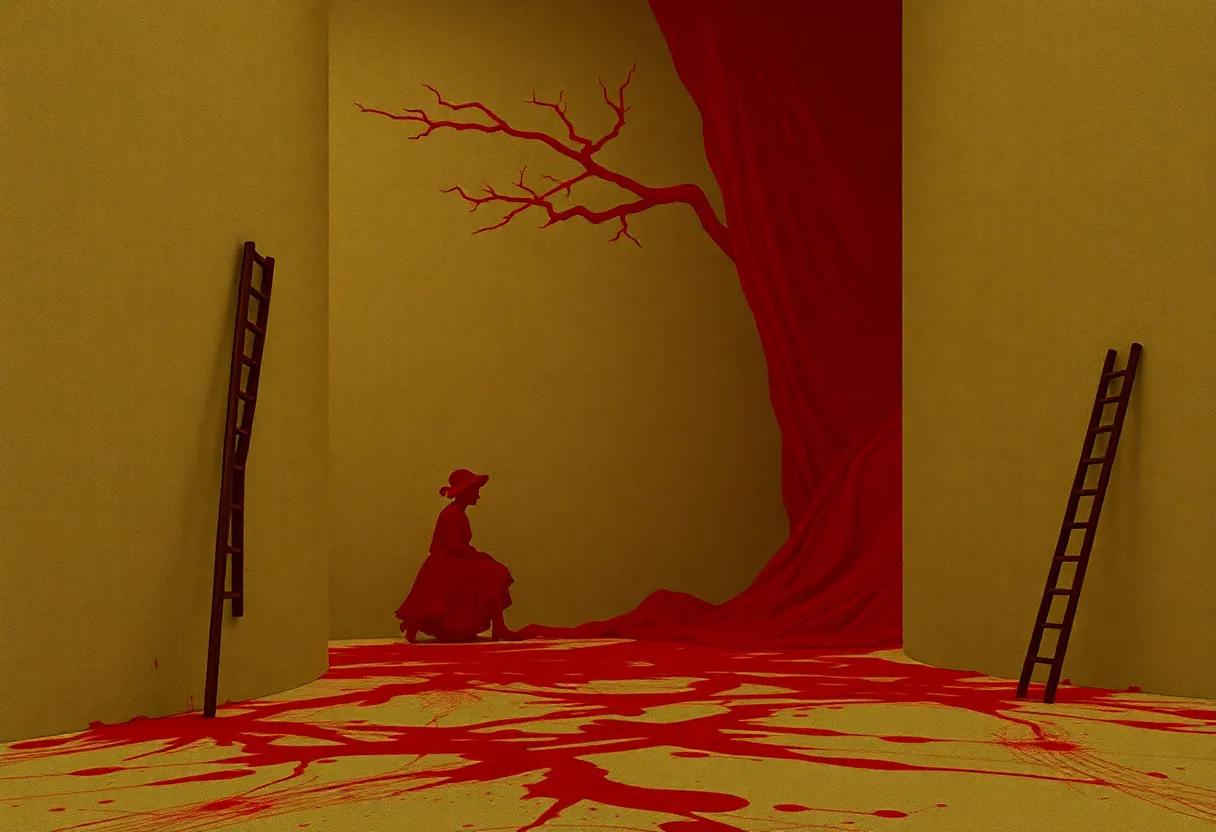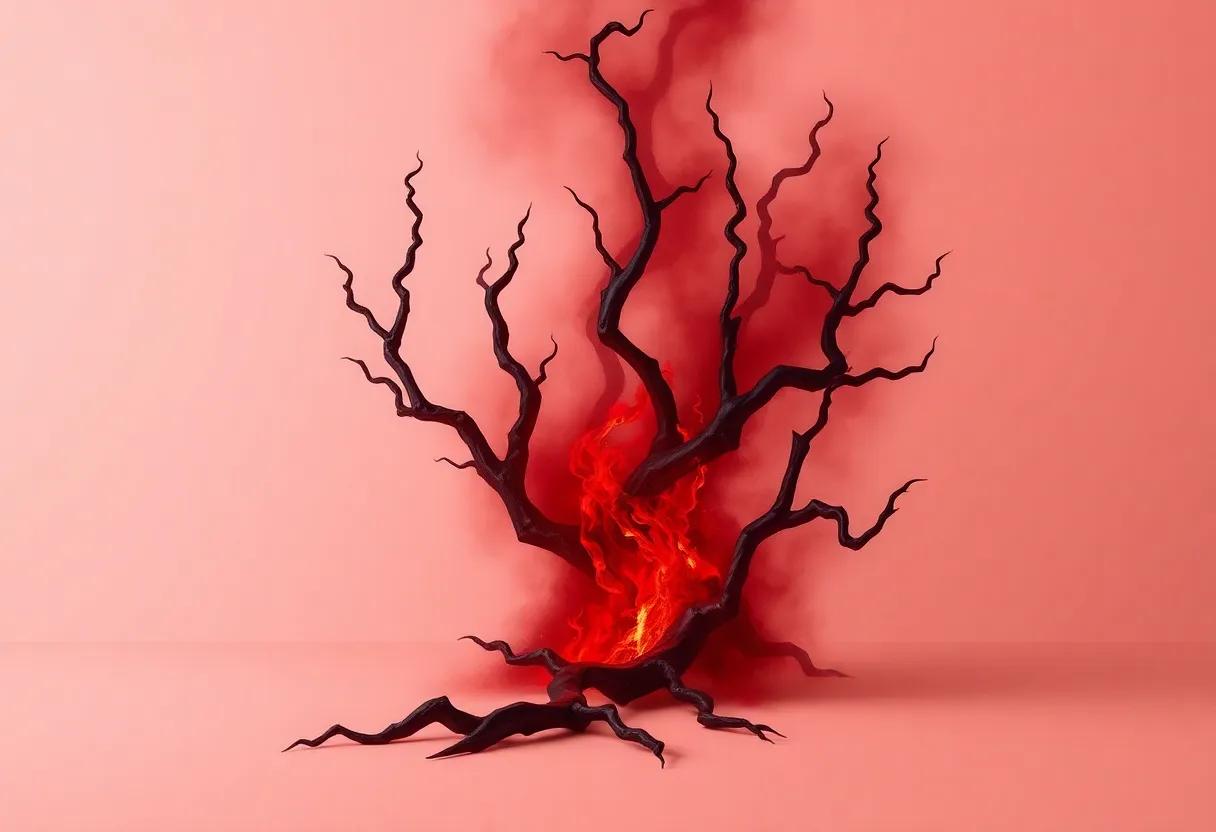In the labyrinth of literary exploration, few works invite as much intrigue and interpretation as Arthur Rimbaud’s A Season in Hell. Descending into Darkness: Unraveling Rimbaud’s A Season in Hell plunges readers into the depths of this enigmatic masterpiece, offering a fresh map through its symbolic shadows and fervent confessions. This study seeks neither to overshadow Rimbaud’s raw intensity nor to demystify his poetic tempest with tidy conclusions; rather, it extends an open hand to guide us through the storm, illuminating the complexities and contradictions that have fascinated scholars and readers alike. In this review, we delve into how Descending into Darkness navigates the precarious terrain of Rimbaud’s hellish season, enriching our understanding while preserving the work’s haunting allure.
Exploring the Haunting Imagery and Symbolism That Define the Core of A Season in Hell
Rimbaud’s masterpiece is drenched in imagery that oscillates between the ethereal and the grotesque, creating a visual tapestry of torment and revelation. Throughout A Season in Hell, the poet harnesses haunting motifs-melancholy landscapes shrouded in mist, spectral figures that haunt fragmented corridors of memory, and flames that both consume and illuminate the self. These visuals are not merely decorative; they serve as portals into the poet’s psyche, exposing the raw nerve of existential anguish and the desperate quest for meaning in a fractured world. The recurring symbols-ice,fire,and shadows-intertwine to reflect the paradoxical nature of suffering and salvation,inviting readers to traverse the thin line between despair and transcendence.
- ice: Represents emotional paralysis and the cold detachment from reality.
- Fire: symbolizes destruction, purification, and the burning away of falsehoods.
- shadows: Embody the inescapable presence of inner demons and obscured truths.
- The abyss: A metaphor for the poet’s confrontation with his own void and existential dread.
To fully grasp the interplay of imagery and symbolism, consider the following simplified table highlighting key motifs and their thematic significance:
| Imagery | Emotional Tone | symbolic Meaning |
|---|---|---|
| Burning towns | Chaos | Internal conflict and destruction |
| Frozen landscapes | Isolation | Emotional numbness |
| Flickering lights | Uncertainty | Fleeting hope amid darkness |
Through this vivid palette, Rimbaud crafts a surreal yet intimate journey-where each image pulses with symbolic weight, inviting readers to peer into the shadows and flames that define the human condition.
A Deep Dive into Rimbaud’s Psyche Through the Fragmented Narrative and Poetic Style
The labyrinthine structure of Rimbaud’s fragmented narrative mirrors the tumultuous unraveling of his own psyche, plunging readers into a world where coherence dissolves into chaos. His use of disjointed verses and abrupt thematic shifts acts as a literary kaleidoscope, fracturing time and experience to reflect his inner discord. This fractured approach strips away the illusion of a linear self, exposing the poet’s confrontation with identity, suffering, and transcendence. The erratic cadence and abrupt transitions are not merely stylistic choices; they function as a visceral depiction of mental fragmentation, which invites the reader to navigate the dark corridors of doubt and revelation alongside him.
Embedded within this narrative discontinuity lies a purposeful interplay between symbolism and stark realism, which compels a multifaceted reading experience:
- Symbolism: Recurring motifs such as hell, darkness, and spiritual exile amplify the emotional and metaphysical struggle, embodying the poet’s quest for meaning amidst despair.
- Poetic Disruption: the juxtaposition of customary poetic forms with abrupt prose passages challenges conventional aesthetics, highlighting the tension between order and chaos.
- Psychological Intensity: The rawness of Rimbaud’s confessions, embedded within this stylistic ambivalence, forges an intimate connection with the reader, breathing life into his existential torment.
| Element | Function in Narrative | Psychological Impact |
|---|---|---|
| Fragmented Structure | Disorients temporal flow | Reflects mental chaos |
| Symbolic Imagery | Evokes metaphysical exile | Amplifies emotional depth |
| Stylistic Paradox | Melds prose with verse | Challenges perception of self |
Unpacking the Themes of despair, Rebellion, and Spiritual Turmoil in the Work
Rimbaud’s A Season in Hell is a labyrinth of emotions where despair seeps into every line like an unyielding shadow. The poet’s confrontation with his own inner darkness reflects a profound alienation-not just from society but from himself. This internal exile is punctuated by moments of raw vulnerability, where the self becomes a fractured mirror, echoing themes of dissolution and loss. His despair is not passive; it is charged with the urgency of someone teetering on the edge, grappling with the collapse of ideals and the crushing weight of disillusionment. In this emotional tempest, the reader is invited to witness the agony of spiritual exile, disparate from hope yet inextricably tied to the quest for meaning.
Interwoven with this despair is a fierce rebellion against convention and morality,an upheaval that refuses to be silenced. Rimbaud’s verses erupt with challenging imagery and paradoxes, turning the idea of salvation on its head and questioning the very foundation of faith and society.His spiritual turmoil manifests as a turbulent dialog between sacred and profane, order and chaos-each poem a battleground where angels and demons wrestle.This struggle is mirrored in the following facets:
- Defiant rejection of institutional religion, exposing hypocrisy and spiritual stagnation.
- Conflicted introspection revealing a soul caught between salvation’s promise and despair’s abyss.
- Explosive language that shatters traditional poetic forms, reflecting inner chaos.
| Theme | Key Symbol | Emotional Impact |
|---|---|---|
| Despair | The Abyss | Hopelessness and isolation |
| Rebellion | Fire | Destruction of norms |
| Spiritual Turmoil | Angel vs. Demon | Inner conflict and doubt |
How the Author connects Historical Context to Rimbaud’s Revolutionary Voice
Embedded within A Season in Hell is a fierce defiance against the socio-political turmoil that defined late 19th-century France. The author masterfully contextualizes Rimbaud’s radical voice by intertwining the poet’s fragmented psyche with the societal fractures of his era – marked by post-war instability,religious skepticism,and the rise of individualism. This historical backdrop is not just a passive setting but acts as a catalyst propelling Rimbaud’s rebellious fervor. Through vivid imagery and raw discourse, the work captures an essential truth: the poet’s descent into darkness mirrors a nation’s struggle to redefine identity amidst chaos.
To further illuminate this connection, the author highlights key elements that forge Rimbaud’s revolutionary tone, presenting them as both personal and political vectors:
- Conflict with Tradition: rimbaud’s rejection of established norms echoes the widespread questioning of authority during the era.
- Spiritual Crisis: A reflection of broader religious disenchantment that permeated French society post-Commune.
- Search for Self: Embodying the existential uncertainty prevalent among the youth facing a fractured world.
| Historical Element | Rimbaud’s Expression | Impact on Revolutionary Voice |
|---|---|---|
| Franco-Prussian War Aftermath | Desolate landscapes, loss, and despair | Intensifies themes of alienation and rebellion |
| Religious Upheaval | Skepticism, blasphemy, and spiritual wrestling | Undermines conventional morality and faith |
| Rise of Individualism | Quest for personal freedom and identity | Frames the poet as a revolutionary iconoclast |
The Role of Mysticism and Existential Angst in Shaping the Text’s Dark Atmosphere
Arthur Rimbaud’s A Season in hell pulsates with an intense interplay of mysticism and existential angst,which serve as twin engines driving the poem’s profound darkness. Throughout the text, Rimbaud grapples with metaphysical questions, transcending earthly confines to plunge into spiritual realms that teeter on the edge of revelation and despair. This mysticism is not traditional or serene but fractured-a chaotic exploration of divine absence and elusive transcendence that engulfs the soul in turmoil. The poem’s atmosphere reflects a restless search for meaning amid a cosmos that feels simultaneously vast and indifferent, amplifying a pervasive sense of alienation and dread.
The existential angst permeating the text is woven through its bleak imagery and fragmented narratives, forging a landscape haunted by self-conflict and disillusionment. Rimbaud’s persona is trapped in the liminal space between rebellion and surrender, caught in a cyclical descent into his own hellish psyche. This tension can be distilled into several thematic currents that crystallize the poem’s dark mood:
- Spiritual Fragmentation: A fracturing of faith that mirrors the speaker’s inner chaos.
- Search for Identity: The painful quest to understand the self beyond social and moral confines.
- Metaphysical Isolation: The feeling of existential solitude in a universe devoid of comforting certainties.
| Mysticism | Existential Angst |
|---|---|
| Elusive divine presence | Inner psychological torment |
| Transcendence and void | Fear of meaninglessness |
| Sacred chaos | Alienation from society |
Comparing A Season in Hell to Rimbaud’s Earlier and Later Works for Broader Understanding
A Season in Hell emerges as a stark pivot in Rimbaud’s poetic journey, contrasting vividly with the earlier effervescent lyricism found in his youthful poems. Where his initial works burst with rebellious exuberance and visionary energy, this prose-poetry hybrid descends into a labyrinth of existential torment and self-exploration.The ecstatic flights of inventiveness in his early pieces give way to a raw, confessional tone that grapples with personal demons and disillusionment. This dramatic shift not only marks a maturation in his voice but also reveals the profound inner conflicts that were merely hinted at in his preceding verses.
Looking ahead to his later works, which are sparse yet crystallize his evolving worldviews, the echoes of A Season in Hell persist in a more subdued and metaphysical form. the bitterness and questioning transform into detached reflections and brief bursts of clarity, illustrating a trajectory from chaotic intensity towards a resigned wisdom. To better visualize this progression, consider the following:
| Period | Tone | Thematic Focus | Stylistic Traits |
|---|---|---|---|
| Early works | Rebellious, vibrant | Freedom, youthful idealism | Lyricism, vivid imagery |
| A Season in Hell | Turbulent, introspective | Existential crisis, self-examination | Prose-poetry, symbolism, allegory |
| Later works | Detached, reflective | Metaphysics, resignation | Conciseness, abstraction |
- Transition in form: From traditional verse to hybrid prose and back to minimalism.
- Evolution of voice: From youthful defiance to anguished self-interrogation and final philosophical distance.
- Shift in themes: Idealism gives way to despair which slowly refines into poignant understanding.
The Impact of Translation choices on conveying Rimbaud’s Intensity and Nuance
Translating Rimbaud’s A season in Hell is akin to walking a tightrope between fidelity and artistic interpretation. Each linguistic choice carries the weight of preserving the poem’s raw intensity and complex emotional palette. When translators opt for literal precision, the visceral, fragmented energy of Rimbaud’s language may feel distilled-clean but detached. Conversely, a more liberal approach can restore the poem’s feverish rhythm and guttural power, yet risk deviating from the poet’s original wording.The challenge lies in balancing clarity with chaos:
- Preserving metaphorical ambiguity without losing readers
- Maintaining the text’s lyrical spontaneity amid structured syntax
- Conveying emotional extremes through nuanced word choices
Consider this comparison of translated excerpts where word choice shifts tone drastically:
| Original (French) | Literal Translation | Interpretative Translation |
|---|---|---|
| “On est venu ici pour des choses graves.” | “We have come here for serious things.” | “We came for weighty matters.” |
| “La souffrance est mon art.” | “Suffering is my art.” | “Agony forms my craft.” |
Words like “grave” versus “weighty,” or “suffering” versus “agony,” subtly shift the poem’s intensity and emotional weight. such nuances illuminate how translation choices shape our access to Rimbaud’s enigmatic voice, influencing not only meaning but also the lingering atmosphere of descent and despair that defines the work.
Recommendations for Readers Seeking a Journey Through Torment and Literary Innovation
For those ready to navigate the turbulent waters of existential agony paired with groundbreaking poetic form, some works stand as essential companions. delving beyond A Season in Hell, consider exploring texts that experiment with language while exposing raw emotional landscapes. These pieces challenge narrative conventions and invite readers into realms where suffering is both a muse and a mirror.Among such literary voyages, the following authors and collections illuminate the interplay between inner torment and stylistic daring:
- Arthur Rimbaud’s own later prose poems that fragment traditional structure to evoke discord and revelation.
- Franz Kafka’s The Metamorphosis, where alienation and surreal transformations dismantle everyday realities.
- Sylvia Plath’s Ariel, a visceral exploration of psychological descent with rhythmic intensity.
- Samuel Beckett’s dramatic works, mastering minimalism to expose human despair in stark, haunting tableaux.
| Work | Theme | Innovation |
|---|---|---|
| A Season in Hell | Self-exile and spiritual crisis | Hybrid prose and poetry |
| The Metamorphosis | Alienation and conversion | Surreal narrative structure |
| Ariel | Psychological torment | Intense lyricism |
| waiting for Godot | Absurdity of existence | Minimalist dialogue |
Immersing oneself in these works can deepen appreciation for rimbaud’s courage to dismantle both personal and poetic boundaries. Each title invites readers not only to witness despair but to experience the alchemy where darkness breeds innovation. Approaching these texts with patience and openness reveals a shared lineage of poets and playwrights who transform turmoil into timeless art.
Analyzing the Book’s Balance Between Critical Analysis and Accessible Interpretation
rimbaud’s A Season in Hell masterfully straddles the fine line between intensive scholarly exploration and an accessible narrative that welcomes readers from all walks of life. The book doesn’t simply present an academic dissection but invites readers into a vivid labyrinth of spiritual and emotional unrest. Its critical analysis digs deep into the symbolism, historical context, and linguistic innovation, while simultaneously offering interpretations that resonate on a personal and philosophical level. This duality ensures that readers aren’t overwhelmed by dense theory nor left craving deeper insight.
To better understand the book’s approach, consider the following characteristics of its analysis and interpretation:
- Analytical depth: Thorough examination of poetic devices and thematic layers.
- Clear explanations: Avoids jargon to maintain readability for general audiences.
- Contextual framing: Situates Rimbaud’s work within broader literary and cultural movements.
- Emotional resonance: Encourages readers to connect with the text’s raw, existential spirit.
| Aspect | Critical Analysis | Accessible Interpretation |
|---|---|---|
| Language | examined for metaphor and innovation | Explained with relatable examples |
| Themes | Deconstructed within 19th-century symbolism | Linked to universal struggles and redemption |
| Structure | Analyzed for fragmented narrative | Introduced as reflective of mental turmoil |
Visualizing the Descent: Suggestions for Artistic representations inspired by the Review
To translate Rimbaud’s tumultuous journey into a visual masterpiece, artists might explore a palette suffused with deep shadows contrasted by sudden bursts of fiery color, capturing the volatile emotions and spiritual torment embedded within A Season in Hell. Imagery could oscillate between abstract forms and symbolic realism, reflecting the poet’s oscillation between clarity and chaos. Consider integrating fractured mirrors or shards of glass within your composition to evoke the fragmented self and the shattering of innocence. These elements invite viewers to immerse themselves in a space where light battles darkness, mirroring Rimbaud’s descent and inner conflict.
Incorporating conceptual layers through mixed media or digital manipulation can further deepen the engagement. Here’s a simple guideline to spark creative decisions:
| Artistic Element | Suggested Symbolism | Possible Mediums |
|---|---|---|
| Color | Crimson for passion and torment, deep indigo for despair | Oil paints, digital gradients |
| Texture | Rough, scratched surfaces for internal struggle | Mixed media, impasto techniques |
| Form | Fragmented, distorted human shapes for identity breakdown | Sculpture, collage |
| Light | Strong contrasts to suggest spiritual illumination and darkness | Photography, chiaroscuro painting |
The Book’s Contribution to Contemporary Rimbaud Scholarship and Its Unique Insights
Breaking away from conventional approaches, this book delves into A Season in Hell with a fresh lens, placing Rimbaud’s tumultuous psyche at the heart of literary experimentation. By intertwining psychoanalytic theory with intertextual analysis, it uncovers previously overlooked nuances-showing how the poem serves not only as a confessional narrative but also as an allegory for spiritual and artistic rebirth. the author’s skillful navigation through rimbaud’s fragmented syntax and bold imagery highlights the poet’s restless quest for identity and transcendence,providing contemporary scholars with valuable interpretive frameworks.
Among its unique offerings, the book presents:
- A comparative table mapping symbol motifs across Rimbaud’s works, illuminating recurring themes and their evolution.
- Contextual exploration of 19th-century socio-political upheavals that subtly inflect the poem’s apocalyptic tone.
- Innovative readings that challenge the dominant narrative of A Season in Hell strictly as an autobiographical confession.
In doing so, it acts as an essential bridge connecting historic criticism with emerging interpretative paradigms, enriching the ongoing discourse around one of poetry’s most enigmatic masterpieces.
| Aspect | Traditional View | New Insight Presented |
|---|---|---|
| Psychological Depth | Fragmented personal crisis | Symbolic spiritual odyssey |
| Language Style | Excessive obscurity | Deliberate experimental syntax |
| Thematic focus | Confession and despair | Rebellion and transformation |
A Closer Look at the Author’s Expertise and Motivations Behind Writing This Review
With a background deeply rooted in comparative literature and a specialization in 19th-century French poetry, the author brings a rigorous analytical framework to this exploration of A Season in Hell. Years of immersion in Symbolist and Decadent movements have fostered a nuanced appreciation for Rimbaud’s fragmented genius and his restless rebellion against conventional forms. This expertise is not just academic; it resonates with a personal quest to understand the darker intricacies of the creative spirit-how pain,alienation,and visionary insight converge in poetic expression.
The motivation driving this review stems from a desire to illuminate the layers of Rimbaud’s torment and transcendence, inviting readers to grapple with the text beyond surface-level interpretation. Emphasizing key themes and stylistic quirks, the author seeks to spark a deeper engagement by highlighting:
- The paradox of suffering and liberation embedded in Rimbaud’s prose poems
- The vivid imagery and symbolism that challenge linear narrative
- The autobiographical echoes reflecting the poet’s own existential descent
| Author’s Key Strengths | Impact on Review |
|---|---|
| Academic rigor | Deep contextualization of historical and literary influences |
| Emotional insight | Capturing Rimbaud’s psychological complexity |
| Creative interpretation | Bringing fresh perspectives to a canonical work |
As we close the final pages of Descending into Darkness: Unraveling Rimbaud’s A Season in Hell, we find ourselves standing at the edge of a labyrinth-its twists both illuminated and shadowed by the book’s insightful guidance. This exploration neither dissolves the mysteries of Rimbaud’s tormented verse nor claims to offer definitive answers; rather, it invites readers to embrace the complexity inherent in his work. In navigating through the abyss of A Season in Hell, the text serves as a thoughtful companion, encouraging a deeper appreciation of the poet’s fractured psyche and the enduring enigma that keeps his words alive. Ultimately,this review marks not an end,but an opening-a prompt to descend further,question more,and perhaps find one’s own light within the darkness.







